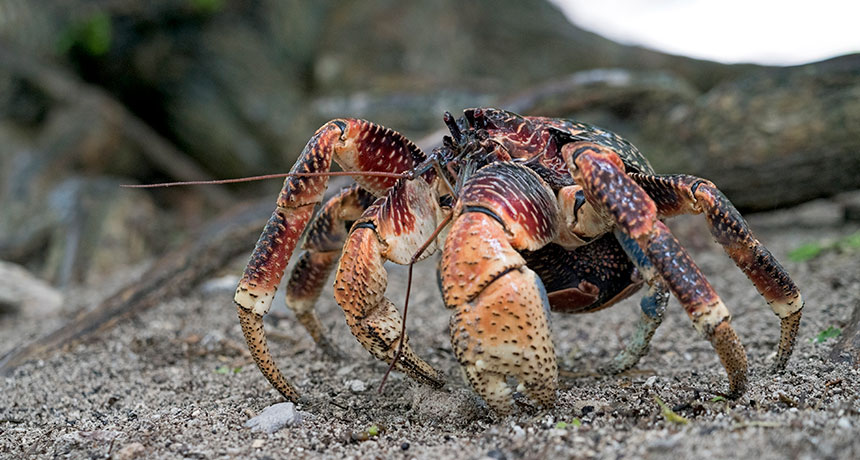Coconut crabs are a bird’s worst nightmare
A biologist documents the balance of crab and bird populations on a remote archipelago

A scientist investigating coconut crabs in a remote Indian Ocean archipelago found evidence that the crabs, the world’s largest terrestrial invertebrates, make terrifying sneak attacks on seabirds.
Janos/iStockphoto
- More than 2 years ago
Imagine you’re a red-footed booby napping on a not-quite-high-enough branch of a tree. It’s nighttime on an island in the middle of the Indian Ocean, and you can’t see much of what’s around you. Then, out of the darkness comes a monster. Its claw grabs you, breaking bones and dragging you to the ground. You don’t realize it yet, but you’re doomed. The creature breaks more of your bones. You struggle, but it’s a fruitless effort. Soon the other monsters smell your blood and converge on your body, ripping it apart over the next few hours.
The monster in this horror-film scenario is a coconut crab, the world’s largest terrestrial invertebrate, which has a leg span wider than a meter and can weigh more than four kilograms.
But this is no page from a screenplay. Biologist Mark Laidre of Dartmouth University actually witnessed this scene in March 2016, during a two-month field expedition to study the crabs in the Chagos Archipelago.
Laidre, an expert on hermit crabs, had been “dying to study” their humongous cousins. Little is known about the crabs, he notes. A study earlier this year looked at the force a coconut crab’s claw can exert in the lab. But, he says, “there’s still not a single paper on how they open a coconut.”
He trekked to the remote spot in the Indian Ocean because he wanted to study the crabs in a place where few people would interfere with their natural behaviors. Laidre had heard stories that coconut crabs killed rats, and he later witnessed them munching on the rodents on the islands. “Clearly it’s in their repertoire to eat something big,” he says. And when he took inventory of the crabs’ burrows, he found the carcass of an almost full-grown red-footed booby in one. “At the time, I had assumed it was something that had died … and the crab had dragged in there,” he recalls.
But then, in the middle of the night, he saw a crab attack a bird sleeping in a tree, and he managed to catch part of the event on film. “I didn’t have the heart to videotape five coconut crabs tearing apart the bird later,” he says. “It was a little bit overwhelming. I had trouble sleeping that night.”
Story continues below video
Mark Laidre caught part of this crab attack on film but didn’t have the heart to turn the camera on later, when five crabs tore the seabird apart. Coconut Crab Conservation/YouTube |
After the event, Laidre heard a story from a local plantation worker who had witnessed something similar a couple of years earlier. “He was sitting and eating a sandwich, and this coconut crab came right out its burrow in the middle of the daytime when … a red-footed booby… landed outside of its burrow,” Laidre says. The crab grabbed the bird’s leg and pulled it into the burrow. “The bird never emerged.”
It’s difficult to tell how often attacks like this happen, whether they’re rare or common. “Predation itself is something you don’t often witness,” Laidre says. He’d like to someday install camera traps on the islands to get a better sense of the crabs’ behavior.
But while he was in the Chagos, he did find himself in a sort of natural experiment that gave him some insight into the effect of the crabs on local bird populations. Coconut crabs live on only some of the islands. Birds can live on any of them, but their populations vary from island to island. So Laidre surveyed the islands, walking transects and counting crabs and bird nests.
“The pattern I found across the island was pronounced,” Laidre writes November 1 in Frontiers in Ecology and the Environment. On Diego Garcia, for example, a 15-kilometer transect revealed 1,000 crabs and no nesting birds. Crab-free West Island, in contrast, had an abundance of ground nests of nesting noddies.
Laidre suspects that the coconut crabs act as a “ruler of the atoll,” keeping ground-nesting bird species from finding homes on crab-filled islands. On other islands with large populations of birds, those birds might help to keep their islands crab-free by eating juvenile coconut crabs, preventing them from colonizing there.
“It’s easy to sympathize with the prey,” Laidre says, “but at the same time, there’s a lot of ecological roles that that sort of action has.”






